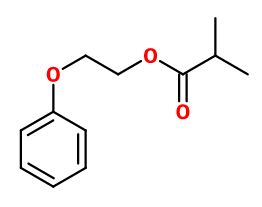Phenoxyethyl IsoButyrate
Synthétique
Fruity > Tropical Fruits > Rosy

Crédits photo: ScenTree SAS
Other names :
Phenirate ; Phenoxyethyl Isobutyrate ; Phenoxyethyl Isobutanoate ; 2-(phenoxy)ethyl-2-methylpropanoate ; Ethylene glycol monophenylether isobutyrate ; 2-phenoxyethyl 2-methylpropanoate
Volatility :
Head/Heart
Uses in perfumery :
Phenoxyethyl IsoButyrate is used to work in particular on fruity notes (red or tropical fruits). It also allows to give facets to floral notes. Interesting for tea or ambery notes.
Natural availability :
Phenoxyethyl IsoButyrate is not available in its natural state.
Year of discovery :
Data not available.
Other comments :
Phenoxyethyl IsoButyrate is olfactively close to Phenyl Ethyl Isobutyrate.
Price Range :
€
Stability :
May form isobutyric acid through time, under the effect of heat.

Crédits photo: ScenTree SAS
- Molecular formula :
- C12H16O3
- Molecular Weight :
- 208,26 g/mol
- Density :
- 1,047
- Flash Point :
- 152°C
- Fusion Point :
- -10°C
- Appearance :
- Colorless liquid
- Log P :
- 3,2
- Boiling Point :
- 275°C
- Detection Threshold :
- 24,8837 ng/l
Synthesis route :
Phenoxyethyl Isobutyrate is synthesized by an esterification reaction, catalysed by a strong acid, between 2-phenoxyethanol and isobutyric acid.
Synthesis precursor :
PhenoxyEthyl IsoButyrate is not a precursor to the synthesis of another compound of olfactory interest.
Isomerism :
Amyl Salicylate is a constitutional isomer of Phenoxyethyl Isobutyrate. Its smell is however more jasmine-like and solar.
- EINECS number :
- 203-127-1
- FEMA number :
- 2873
- JECFA number :
- 1028
- FLAVIS number :
- 09.487
- Allergens :
- This ingredient does not contain any allergen.
- IFRA :
- This ingredient is not restricted
To learn more about IFRA's standards : https://ifrafragrance.org/safe-use/library
ScenTree is solely responsible for the information provided here.

